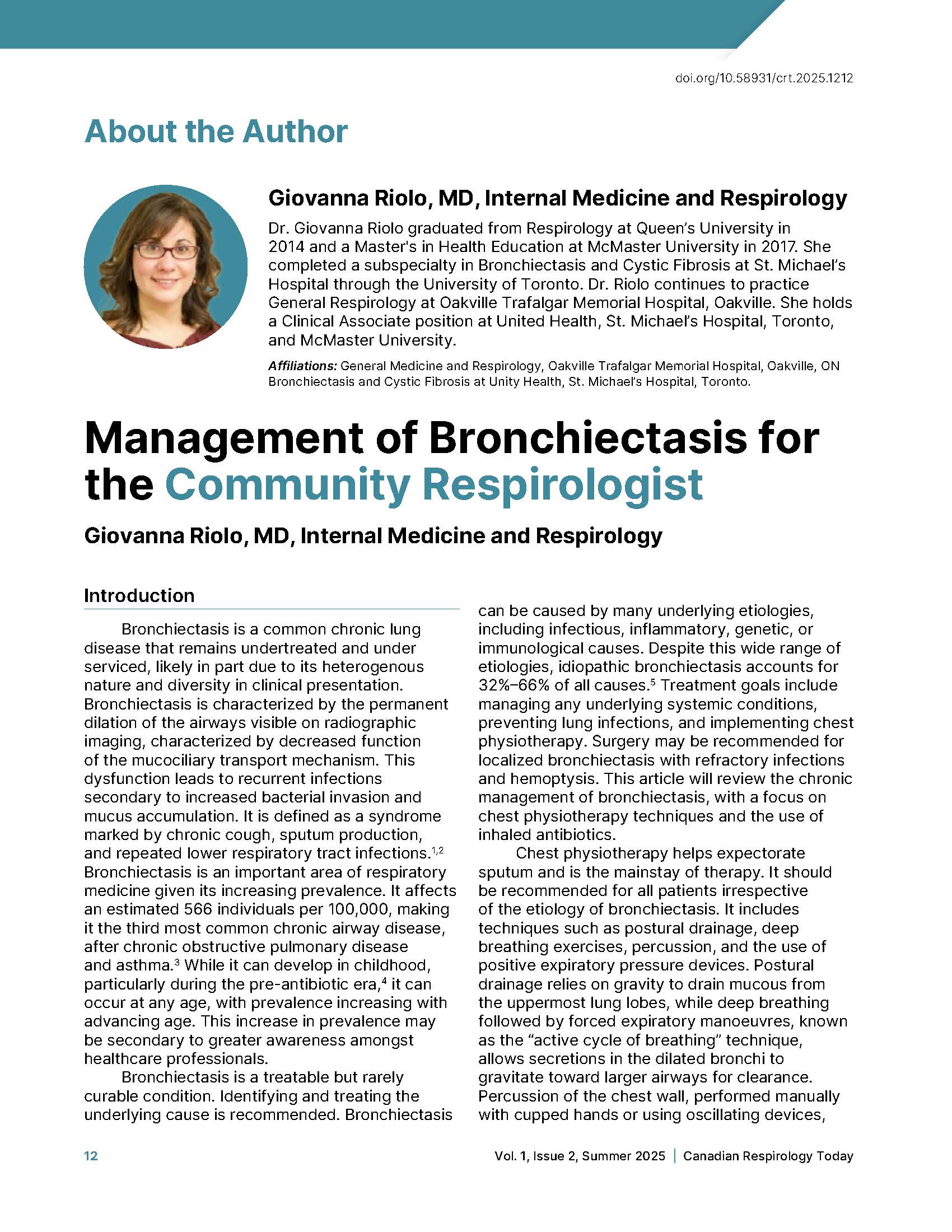Management of Bronchiectasis for the Community Respirologist
DOI:
https://doi.org/10.58931/crt.2025.1212Abstract
Bronchiectasis is a common chronic lung disease that remains undertreated and under serviced, likely in part due to its heterogenous nature and diversity in clinical presentation. Bronchiectasis is characterized by the permanent dilation of the airways visible on radiographic imaging, characterized by decreased function of the mucociliary transport mechanism. This dysfunction leads to recurrent infections secondary to increased bacterial invasion and mucus accumulation. It is defined as a syndrome marked by chronic cough, sputum production, and repeated lower respiratory tract infections. Bronchiectasis is an important area of respiratory medicine given its increasing prevalence. It affects an estimated 566 individuals per 100,000, making it the third most common chronic airway disease, after chronic obstructive pulmonary disease and asthma. While it can develop in childhood, particularly during the pre-antibiotic era, it can occur at any age, with prevalence increasing with advancing age. This increase in prevalence may be secondary to greater awareness amongst healthcare professionals.
Bronchiectasis is a treatable but rarely curable condition. Identifying and treating the underlying cause is recommended. Bronchiectasis can be caused by many underlying etiologies, including infectious, inflammatory, genetic, or immunological causes. Despite this wide range of etiologies, idiopathic bronchiectasis accounts for 32%–66% of all causes. Treatment goals include managing any underlying systemic conditions, preventing lung infections, and implementing chest physiotherapy. Surgery may be recommended for localized bronchiectasis with refractory infections and hemoptysis. This article will review the chronic management of bronchiectasis, with a focus on chest physiotherapy techniques and the use of inhaled antibiotics.
References
Polverino E, Goeminne PC, McDonnell MJ, Aliberti S, Marshall SE, Loebinger MR, et al., European Respiratory Society guidelines for the management of adult bronchiectasis. Eur Respir J. 2017;50(3):1700629. doi:10.1183/13993003.00629-2017
EMBARC. EMBARC- What is bronchiectasis? The European Bronchiectasis Registry. 2025. [Accessed 28 June 2021]. Available from: https://www.bronchiectasis.eu/what-is-bronchiectasis
Cohen R, Shteinberg M. Diagnosis and evaluation of bronchiectasis. Clin Chest Med. 2022;43(1):7–22. doi:10.1016/j.ccm.2021.11.001
Goeminne PC, Hernandez F, Diel R, Filonenko A, Hughes R, Juelich F, et al. The economic burden of bronchiectasis - known and unknown: a systematic review. BMC Pulm Med. 2019;19(1):54. doi:10.1186/s12890-019-0818-6
Chalmers JD, Chang AB, Chotirmall SH, Dhar R, McShane PJ. Bronchiectasis. Nat Rev Dis Primers. 2018;4(1):45. doi:10.1038/s41572-018-0042-3
Chalmers JD, Polverino E, Crichton ML, Ringshausen E, De Soyza A, Vendrell M, et al. Bronchiectasis in Europe: data on disease characteristics from the European Bronchiectasis registry (EMBARC). Lancet Respir Med. 2023;11(7):637-649. doi:10.1016/S2213-2600(23)00093-0
Dhar R, Singh S, Talwar D, Murali MohanBV, Kant Tripathi S, Swarnakar R, et al. Clinical outcomes of bronchiectasis in India: data from the EMBARC/Respiratory Research Network of India registry. Eur Respir J. 2023;61(1):2200611. doi:10.1183/13993003.00611-2022
Aliberti S, Lonni S. Dore S, McDonnell MJ, Goeminne PC, Dimakou K, et al. Clinical phenotypes in adult patients with bronchiectasis. Eur Respir J. 2016;47(4):1113-1122. doi:10.1183/13993003.01899-2015
Iglewski BH. Pseudomonas. In: Baron S, editor. Medical Microbiology. 4th edition. Galveston (TX): University of Texas Medical Branch at Galveston; 1996. Chapter 27. Available from: https://www.ncbi.nlm.nih.gov/books/NBK8326/
Riquelme SA, Liimatta K, Wong Fok Lung T, Fields B, Ahn D, Chen D, et al. Pseudomonas aeruginosa utilizes host-derived itaconate to redirect its metabolism to promote biofilm formation. Cell Metab. 2020;31(6):1091-1106.e6. doi:10.1016/j.cmet.2020.04.017
Haworth CS, Foweraker JE, Wilkinson P, Kenyon RF, Bilton B. Inhaled colistin in patients with bronchiectasis and chronic Pseudomonas aeruginosa infection. Am J Respir Crit Care Med. 2014;189(8):975-982. doi:10.1164/rccm.201312-2208OC
Haworth CS, Shteinberg M, Winthrop K, Barker A, Blasi F, Dimakou K, et al., Inhaled colistimethate sodium in patients with bronchiectasis and Pseudomonas aeruginosa infection: results of PROMIS-I and PROMIS-II, two randomised, double-blind, placebo-controlled phase 3 trials assessing safety and efficacy over 12 months. Lancet Respir Med. 2024;12(10):787-798. doi:10.1016/S2213-2600(24)00225-X
Bilton D, Henig N, Morrissey B, Gotfried M, Addition of inhaled tobramycin to ciprofloxacin for acute exacerbations of Pseudomonas aeruginosa infection in adult bronchiectasis. Chest. 2006;130 (5):1503–1510. doi:10.1378/chest.130.5.1503
Orriols R, Hernando R, Ferrer A, Terradas S, Montoro B. Eradication therapy against Pseudomonas aeruginosa in non-cystic fibrosis bronchiectasis. Respiration. 2015;90 (4):299–305. doi:10.1159/000438490
Elborna JS, Blasib F, Haworth CS, Ballmanne M, et al. Bronchiectasis and inhaled tobramycin: a literature review. Respir Med. 2022;192:106728. doi:10.1016/j.rmed.2021.106728
Scheinberg P, Shore E. A pilot study of the safety and efficacy of tobramycin solution for inhalation in patients with severe bronchiectasis. Chest. 2005;127(4):1420–1426. doi:10.1378/chest.127.4.1420
Loebinger MR, Polverino E, Chalmers JD, Tiddens HAWM, Goossens H, Tunney M, et al. Efficacy and safety of TOBI Podhaler® in Pseudomonas aeruginosa-infected bronchiectasis patients: iBEST study. Eur Respir J. 2021;57(1):2001451. doi:10.1183/13993003.01451-2020 .
Pasteur MC, Bilton D, Hill AT, British thoracic society bronchiectasis (non-CF) guideline group. British thoracic society guideline for non-CF bronchiectasis. Thorax. 2010;6 (suppl 1): i1–i58. doi:10.1136/thx.2010.136119
Hill AT, Sullivan AL, Chalmers JD, De Soyza A, Elborn SJ, Floto AR, et al. British thoracic society guideline for bronchiectasis in adults. Thorax. 2019;74 (suppl 1):1–69. doi:10.1136/thoraxjnl-2018-212463


